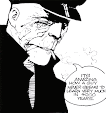This looks like it might be of interest to anyone who thinks about the art, craft and science of creating stories.
It's on More4 at 9pm on Saturday 7 January, but I'm guessing it'll be on the 4oD on-demand service afterwards.
WHAT MAKES A MASTERPIECE? 1/3: Stories and Film
We have always thought that the power of great art lies in its mysterious ability to move us. But now science is claiming to have discovered the secret to why we like what we like, and is challenging some of our most deeply held beliefs about the arts.
Presented by Matthew Cain, Culture Editor of Channel 4 News, this three-part series explores the world of art through the prism of 'neuro-aesthetics': a field of scientific research that looks at how the human brain processes art.
Each episode focuses on a different art form, as Cain explores some surprising theories about how art affects us and asks if neuroscience could radically change our attitudes to human creativity. This first episode looks at stories and film.
Advances in neuroscience are allowing scientists to measure exactly what goes on in our brains when the cinema lights go down and the action begins. Matthew Cain learns why Jaws is so effective and why we're drawn to horror movies, and finds out about the neurons that actually make us 'feel' the fear and tension.
One experiment even shows just how differently men and women respond to the same scene in a James Bond movie, prompting the question: if directors want to fill the multiplexes, should they make his and hers versions of the same film?
And if science has found the answers, will it be used to manipulate what we think, what we like and even what we buy? Cain sees how advertisers are using science to read our subconscious responses to commercials in order to create the most effective ads.
Matthew also meets Christopher Booker, who believes that every story ever told adheres to one of seven basic plots; and Gurindha Chada, the director of Bend It Like Beckham and Bride and Prejudice, who talks about the formula of storytelling.
Finally, Matthew tries to put the principles he has learned to the test when he makes an animated story of his own and measures its effect on the brain.
What I did in 2025
1 day ago



No comments:
Post a Comment